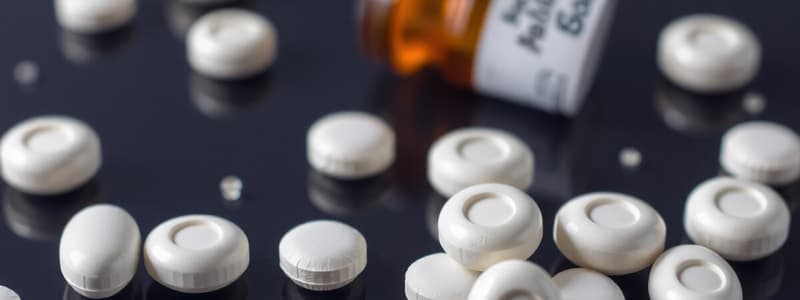Podcast
Questions and Answers
What is the term used for the fraction of an uncharged drug reaching systemic circulation after any route of administration?
What is the term used for the fraction of an uncharged drug reaching systemic circulation after any route of administration?
- Pharmacodynamics
- Therapeutic index
- First-pass metabolism
- Bioavailability (correct)
Which route of drug administration is most likely to undergo the first-pass effect?
Which route of drug administration is most likely to undergo the first-pass effect?
- Intravenous
- Topical
- Subcutaneous
- Oral (correct)
What defines the drug's half-life (t½)?
What defines the drug's half-life (t½)?
- Time required to reduce plasma drug concentration by half (correct)
- Time taken for plasma concentration to reach zero
- Time to reach maximum concentration
- Total time for drug elimination
Which drug acts as an alpha-2 adrenergic receptor antagonist with aphrodisiac properties?
Which drug acts as an alpha-2 adrenergic receptor antagonist with aphrodisiac properties?
Which drug is a noncatecholamine dual-acting adrenergic drug that induces tachyphylaxis?
Which drug is a noncatecholamine dual-acting adrenergic drug that induces tachyphylaxis?
Which type of antagonism exists between adrenaline and histamine?
Which type of antagonism exists between adrenaline and histamine?
Which of the following restricts many drugs' entry into the brain and is made up of P-glycoprotein efflux carriers?
Which of the following restricts many drugs' entry into the brain and is made up of P-glycoprotein efflux carriers?
Which drug is used for treating hypertension by inhibiting noradrenaline storage?
Which drug is used for treating hypertension by inhibiting noradrenaline storage?
Which drug serves as a cardio-selective beta blocker without causing pulmonary side effects?
Which drug serves as a cardio-selective beta blocker without causing pulmonary side effects?
What is the primary effect of adrenaline when injected alongside a local anesthetic?
What is the primary effect of adrenaline when injected alongside a local anesthetic?
Flashcards are hidden until you start studying
Study Notes
Pharmacokinetics
- Bioavailability: The fraction of an uncharged drug reaching the systemic circulation following any route of administration.
- Therapeutic Effect: The drug's primary effect.
- First-Pass Effect: This effect is most likely to occur when drugs are administered orally.
Adrenergic Drugs and Antagonists
- Estrogen: A liver microsomal enzyme inhibitor.
- Adrenaline (Epinephrine): This drug can be injected with a local anesthetic to prolong its duration. It is also a catecholamine used for the same purpose.
- Physiological Antagonisms: The relationship between adrenaline and histamine.
- Magnesium Sulfate: Produces qualitatively different actions when administered through various routes.
- Vohimbine: An alpha-2 adrenergic receptor antagonist with aphrodisiac activities.
- Ephedrine: A noncatecholamine dual-acting adrenergic drug which induces tachyphylaxis.
- Blood-brain Barrier: Restricts the entry of many drugs into the brain and is constituted by P-glycoprotein efflux carriers in brain capillary cells.
- Adrenaline (Epinephrine): Metabolized by MAO and COMT.
- Phentolamine: Induces orthostatic hypotension as a side effect.
- Amphetamine: Acts indirectly by enhancing the release of catecholamines.
- Reserpine: Used for the treatment of hypertension through its inhibitory action on noradrenaline storage.
- Guanethidine: Used for the treatment of hypertension through its inhibitory action on noradrenaline release.
- Atenolol: A cardio-selective beta blocker with no pulmonary side effects. Also suitable for treating angina in asthmatic patients.
Studying That Suits You
Use AI to generate personalized quizzes and flashcards to suit your learning preferences.




